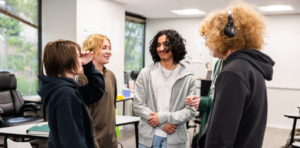Curriculum
The Sycamore School integrates academic development, social-emotional development and civic engagement. Our curriculum encompasses elements of the following evidence-based educational models:

Mastery-based learning describes an approach to learning that is based on individual proficiency. In practice, mastery-based learning allows students to spend as much or as little time as they need on a particular skill or knowledge area.
Why mastery-based learning?
Conventional instruction is time-based; teachers have a fixed time allotted to review each skill or knowledge area. Using this model, a student may pick up some concepts quickly, creating wasted time, when the student becomes bored or disinterested; another student may not fully master a topic in a given timeframe, leading to gaps in learning that grow more significant over time. Mastery-based instruction allows each student to progress at their own pace, accounting for the ebb and flow of learning. This model removes all time-based measurements so that students can move on to a new topic, as soon as they demonstrate competency in a subject area. The goal of mastery-based learning is for students to take what they learn and apply skills and knowledge across other disciplines/content areas to solve unfamiliar problems.
Key components of mastery-based learning:
- Self-paced learning: students master skills at their own pace; students move forward based on their ability to demonstrate competency, not on instruction time.
- Teaching for mastery: students work on a concept until they demonstrate proficiency in the skill; they are given regular feedback and multiple opportunities to improve their work.
- Personalized instruction with student choice: assignments are differentiated based on individual strengths, struggles, and interests; students are given choices on how the material is presented, how they work with concepts and how they show what they know.
- Problem-based learning: assignments are meaningful and often center around problem-solving, encouraging students to explore big ideas and expand their understanding of key concepts.
- Authentic assessment: teachers assess student learning throughout each class and using multiple forms of assessment.
- Focus on the application of skills: students are given opportunities to connect their learning across content areas and to our larger world.

Universal Design for Learning (UDL) provides a framework for understanding how to create curricula that meet the needs of all learners.
UDL provides a blueprint for creating instructional goals, methods, materials, and assessments that work for everyone -- not a single, one-size-fits-all solution but rather flexible approaches that can be customized and adjusted for individual needs. (National Center on Universal Design for Learning, 2012)
Three Primary Principles of UDL (CAST, 2015):
1. Provide multiple means of presentation – give students choices of how the learning material is presented (e.g., visual, auditory or kinesthetic)
2. Provide multiple means of action and expression – give students choices of how they show what they know (offer multiple modes of assessment, such as written and verbal)
3. Provide multiple means of engagement – give students choices of how they work with the material (e.g., alone, in pairs, or group instruction)
How The Sycamore School Applies UDL Concepts:
Students will have choices of how they access academic material and demonstrate mastery (e.g., show what they know). This is done by providing students “menus” where they pick which activities they would like to do in order to learn a concept. Each core class (i.e., language arts, science, social studies, math) will offer individual, small and large group learning opportunities. Technology is used creatively to provide students learning options.
For more information on Universal Design for Learning, go to CAST www.cast.org.

Collaborative for Academic, Social, & Emotional Learning (CASEL) outlines evidence-based strategies to incorporate social and emotional learning with academic instruction.
“Social and emotional learning (SEL) is the process through which children and adults acquire and effectively apply the knowledge, attitudes, and skills necessary to understand and manage emotions, set and achieve positive goals, feel and show empathy for others, establish and maintain positive relationships, and make responsible decisions.” CASEL 2015
CASEL has identified five interrelated Social & Emotional Learning Core Competencies:
- Self-Management
- Self-Awareness
- Responsible Decision-Making
- Relationship Skills
- Social Awareness
What is Mindfulness?
- The ability to focus on what you want, when you want.
- Increased awareness of thoughts, emotions, senses, and external behaviors.
- Non-reactivity; the ability to let sensory experience come and go without push or pull.
What are the Benefits of Mindfulness?
When students can effectively manage their emotions, they are more available for learning.
Research findings show that practicing mindfulness can improve students’:
- Attention
- Emotional Regulation
- Adaptability
- Compassion
- Calming
- Resilience
How do you teach Mindfulness?
- Teach tools– explicitly teach students mindfulness activities
- Regular practice– create a regular time for mindfulness practice in the classroom
- Cue/Prompt– cue students to practice their mindfulness when they are visibly dysregulated
Three ways Social & Emotional Learning will be addressed in the TSS school community:
- Explicit Social & Emotional Skills Instruction
- Integrate Social & Emotional Learning within Academic Curriculum Areas
- Teacher Instructional Practices reflect both social & emotional, and academic goals
For more information on Social & Emotional Curricula, go to www.casel.org

